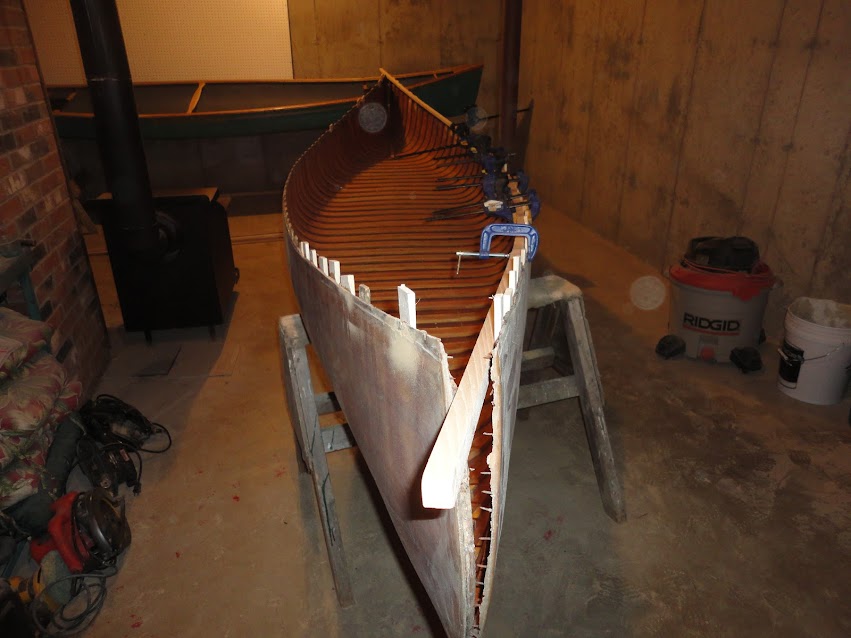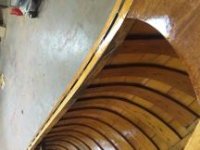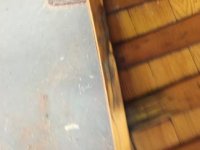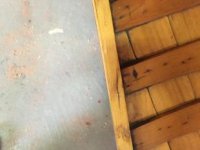-
Happy Winter Solstice! 🌇🌃
You are using an out of date browser. It may not display this or other websites correctly.
You should upgrade or use an alternative browser.
You should upgrade or use an alternative browser.
newbie paddler
- Thread starter johnp
- Start date
That raises so many questions. What type of canoe? Are they wood or aluminum or composite or plastic? Are there decks involved? Are they glued or screwed or riveted? Can you post some pictures?
When you say "inwales" are you talking about a wood canvas canoe? Replacing inwales/gunnels on a plastic canoe is pretty easy, inwales on a wood canvas canoe is not as easy but not that hard that someone who has never done it shouldn't try.
And once you get them off what can of worms have you opened up?
Here's some pictures of a 15' Old Town Trapper that came from the factory with a fiberglass rather than canvas covering. I have done both glass and canvas and it's pretty much the same procedure.
The nails holding the ribs to the inwales are probably ring nails but they could be other style nails, you can pull the nails from the outside with a tack puller, or pry the rib tip from the inwale with a small putty knife or cut the nails with a hack saw blade.
You will have to renail all the ribs to the new inwales with 2 ring nails each rib tip, I start at the center of the canoe. You will also have to steam the new bend in the inwales at the shearline if it has a big curve at the ends before trying to nail.
Don't worry about the canoe falling apart or loosing it's shape without the inwales, if it has most of the plank still in place, it will hold together fine and will not loose it's shape. If you leave the canoe overnight you can wrap a rope around it at the center for piece of mind.
The book "This Old Canoe" by Mike Elliott covers the procedure with excellent detail. The book is really an great source of information for a wood canvas canoe restoration and the money you save making your own canvas filler with his formula and instructions will pay for the book itself.
Here's those pics of new inwales on the OT Trapper, it really makes the canoe look so much better.
new rib tips being glued before new inwales are installed,

clamping in new inwale, these inwales didn't need to be steamed first,

Openning up the area around the stem can help,


new inwales make it look really nice imo,

new inwales and gunnels, no decks yet.

The nails holding the ribs to the inwales are probably ring nails but they could be other style nails, you can pull the nails from the outside with a tack puller, or pry the rib tip from the inwale with a small putty knife or cut the nails with a hack saw blade.
You will have to renail all the ribs to the new inwales with 2 ring nails each rib tip, I start at the center of the canoe. You will also have to steam the new bend in the inwales at the shearline if it has a big curve at the ends before trying to nail.
Don't worry about the canoe falling apart or loosing it's shape without the inwales, if it has most of the plank still in place, it will hold together fine and will not loose it's shape. If you leave the canoe overnight you can wrap a rope around it at the center for piece of mind.
The book "This Old Canoe" by Mike Elliott covers the procedure with excellent detail. The book is really an great source of information for a wood canvas canoe restoration and the money you save making your own canvas filler with his formula and instructions will pay for the book itself.
Here's those pics of new inwales on the OT Trapper, it really makes the canoe look so much better.
new rib tips being glued before new inwales are installed,
clamping in new inwale, these inwales didn't need to be steamed first,
Openning up the area around the stem can help,
new inwales make it look really nice imo,
new inwales and gunnels, no decks yet.
It's a little tough to tell by those pics but if that is the worst part of the inwales I would try drilling 1/4" holes from the bottom of the inwale but being careful not to penetrate the upper side of the inwale. Even if you have to drill at an angle if the drill won't fit squarely against the ribs. Then turn the canoe upside down, use some Tightbond II or III with some dowels in each hole, and clamp tight for a day or two. Maybe a inch between dowels. Then belt sand the inwale to clean it up.
Are the tips/ends of the gunnels good? Are the decks good?
Are the tips/ends of the gunnels good? Are the decks good?
The gunnels are perfect, I was only concerned about the cracks and splits on the inner gunnels. Since I need to do the canvas I thought it would be The time to do the inwales. It looks like a lot more work though. If they'll be ok I'll leave them.
Is it a SHOW canoe or a User?
- Joined
- Mar 20, 2013
- Messages
- 3,356
- Reaction score
- 972
Fill the crack with epoxy, clamp and refinish( after the epoxy has cured, you can take the inwale off the canoe if you need to do some other work!
I've filled similiar cracks on inwales before and even on the present project. I used a clear finish resin, West System is what I can get and a heat gun. Mix a small batch of epoxy and heat up the crack area well. Put the epoxy in the crack, as the wood cools it will pull the resin into the crack, repeat until the crack is full. Pot life of the resin should not be an issue, doesn't take as long as it sounds and you will get the best penetration of the crack. If necessary you can clamp the area while the resin cures.
Karin
Karin
Similar threads
- Replies
- 58
- Views
- 8K
- Replies
- 40
- Views
- 4K
- Replies
- 9
- Views
- 915



